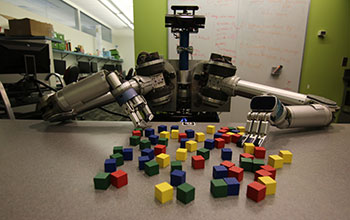Multimedia Gallery
Robots get creative to cut through clutter
Carnegie Mellon University researchers have developed an algorithm to help mobile robots decide which objects need to be picked up and moved and which ones can be safely pushed aside to accomplish a task. Here, the algorithm enables a robot called HERB (for the Home Exploring Robot Butler) to pick up blocks.
More about this image
Clutter is a special challenge for robots, but new Carnegie Mellon University (CMU) software is helping robots cope, whether they're beating a path across the moon or grabbing a gallon of milk from the back of the refrigerator. CMU researchers developed an algorithm to help mobile robots decide which objects need to be picked up and moved and which ones can be safely pushed aside to accomplish a task. The software not only helped a robot deal efficiently with clutter, but it also surprisingly revealed the robot's creativity in solving problems.
"It was exploiting sort of superhuman capabilities," said Siddhartha Srinivasa, an associate professor of robotics, of his lab's two-armed, mobile robot called the Home Exploring Robot Butler, or HERB. "The robot's wrist has a 270-degree range, which led to behaviors we didn't expect. Sometimes, we're blinded by our own anthropomorphism."
In one case, the robot used the crook of its arm to cradle an object to be moved. "We never taught it that," Srinivasa added.
This research was supported in part by a grant from the National Science Foundation.
To learn more, see the CMU news story Robots get creative to cut through clutter. (Date image taken: 2016; date originally posted to NSF Multimedia Gallery: Aug. 5, 2016)
Credit: Carnegie Mellon University
See other images like this on your iPhone or iPad download NSF Science Zone on the Apple App Store.
Images and other media in the National Science Foundation Multimedia Gallery are available for use in print and electronic material by NSF employees, members of the media, university staff, teachers and the general public. All media in the gallery are intended for personal, educational and nonprofit/non-commercial use only.
Images credited to the National Science Foundation, a federal agency, are in the public domain. The images were created by employees of the United States Government as part of their official duties or prepared by contractors as "works for hire" for NSF. You may freely use NSF-credited images and, at your discretion, credit NSF with a "Courtesy: National Science Foundation" notation.
Additional information about general usage can be found in Conditions.
Also Available:
Download the high-resolution JPG version of the image. (3.9 MB)
Use your mouse to right-click (Mac users may need to Ctrl-click) the link above and choose the option that will save the file or target to your computer.

